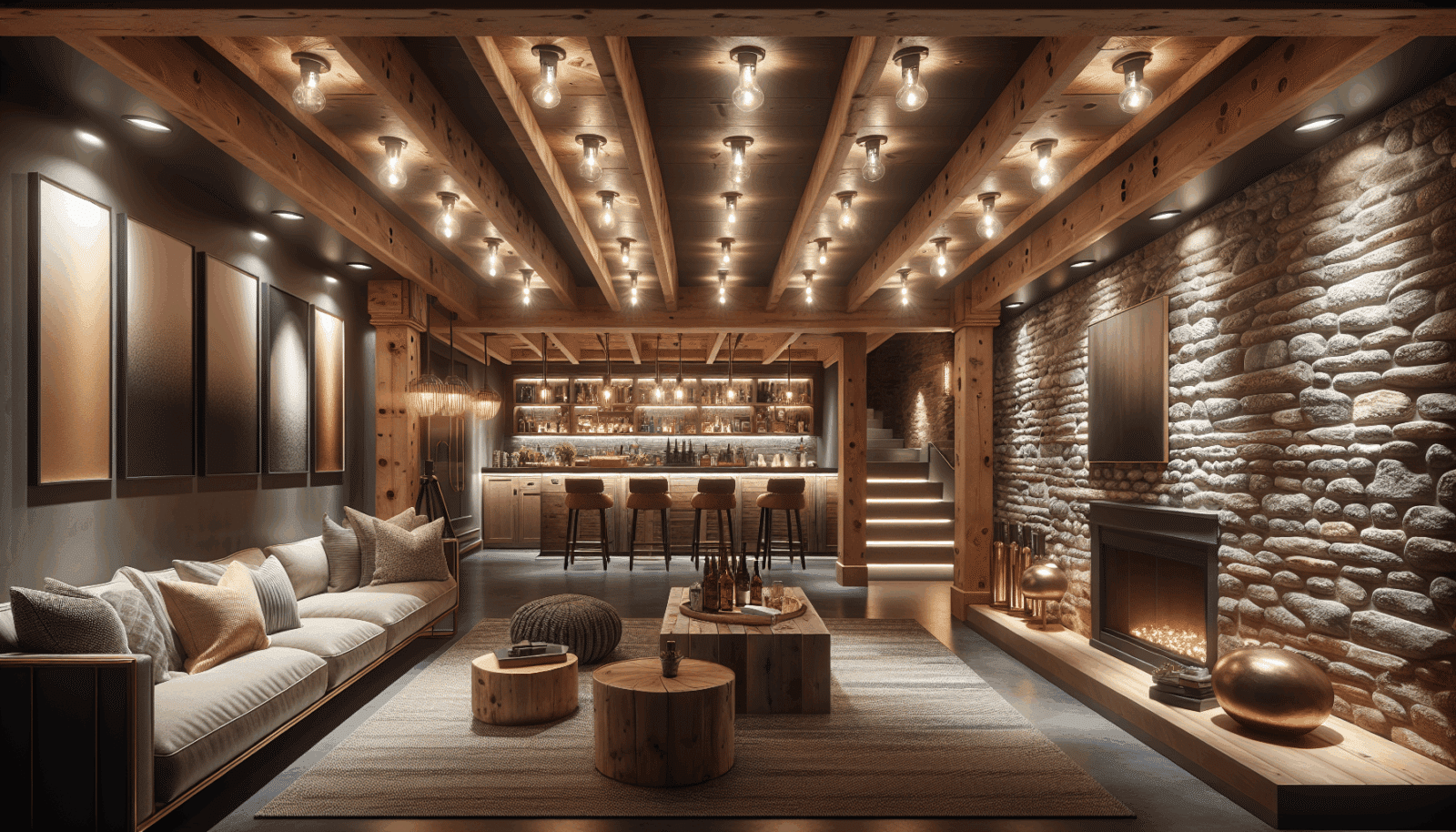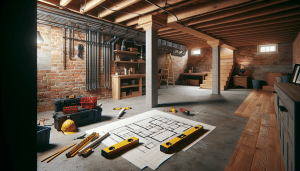At Utah Basement Finishing, we know that transforming your basement can be a daunting task, especially when it comes to lighting. Poor lighting can make your basement feel dark and uninviting. But don’t worry, we’ve got you covered. This article will help homeowners create a well-lit, welcoming space that enhances the beauty and functionality of your basement.
Contents
- 1 Understanding the Importance of Basement Lighting
- 2 Evaluate Your Basement’s Natural Light
- 3 Layering Your Lighting
- 4 Choosing the Right Fixtures
- 5 Soft and Warm Lighting
- 6 Maximizing Small Spaces
- 7 Incorporating Smart Lighting Solutions
- 8 Focus on Energy Efficiency
- 9 Highlighting Key Areas
- 10 Creating the Ultimate Home Theater
Understanding the Importance of Basement Lighting
Lighting is a crucial aspect of basement design. It not only illuminates the space but also enhances the ambiance. Proper lighting can turn your basement from a dim, underused area to a vibrant, multifunctional room. Whether you’re setting up a home theater, a game room, or a cozy guest suite, the right lighting will make all the difference.
Moreover, lighting can affect your mood and productivity. Bright, well-distributed light promotes a cheerful environment, while poor lighting can lead to a gloomy atmosphere. That’s why focusing on expert lighting tips can significantly improve your basement’s overall appeal and usability.
Evaluate Your Basement’s Natural Light
Before you start adding artificial lighting, assess the natural light that your basement receives. Many basements have limited Windows, but even small windows can be optimized to bring in more light. Remove any obstructions that might be blocking natural light, such as heavy curtains or large furniture.
Consider installing larger windows or light wells if possible. These modifications can increase natural light and reduce your need for artificial lighting during the day. Light-colored walls and ceilings also help reflect natural light, making the space feel brighter.
Layering Your Lighting
To create a well-lit basement, it’s essential to use multiple layers of lighting: ambient, task, and accent lighting. This comprehensive approach ensures that every part of the room is adequately lit and serves its intended purpose.
Ambient lighting is the foundation. This general lighting should cover the entire space, making it easy to move around safely. Examples includes recessed lights or ceiling-mounted fixtures.
Task lighting is more focused. It illuminates specific areas where activities like reading, cooking, or working will take place. Think under-cabinet lights in a kitchenette or desk lamps in a home office.
Accent lighting adds a decorative touch. It highlights features such as artwork, architectural details, or a home bar. Consider using spotlights or LED strips to create visual interest.
Choosing the Right Fixtures
Selecting the appropriate lighting fixtures can help you achieve the look and feel you desire for your basement.
Ceiling-mounted fixtures and recessed lights are excellent choices for ambient lighting as they provide widespread illumination without taking up floor space. Pendant lights and chandeliers can add a stylish touch, particularly over dining areas or kitchen islands.
For task lighting, consider desk lamps, under-cabinet lighting, and floor lamps. Portable light fixtures such as table lamps are versatile and can be moved as needed.
Soft and Warm Lighting
Choosing the right color temperature is essential for creating a comfortable atmosphere in your basement. Warm lighting (2700K-3000K) makes the space feel cozy and inviting, while cool lighting (3500K-4100K) is more energizing and bright.
We recommend using soft, warm lighting for relaxation areas such as family rooms, guest rooms, and home theaters. In contrast, cooler lighting works well in workspaces like home offices or craft rooms.
Dimmer switches can offer greater control over the light intensity, allowing you to adjust the mood according to the activity.
Maximizing Small Spaces
Lighting can play a vital role in making small basement spaces feel larger and more open. Use bright, even lighting to eliminate shadows and create an illusion of space.
Mirrors and reflective surfaces can also enhance the effect of lighting, making the room appear bigger and brighter. Strategically placed mirrors can reflect both natural and artificial light, amplifying its impact.
Keep clutter to a minimum and opt for streamlined furniture to maintain an airy feel.
Incorporating Smart Lighting Solutions
Smart lighting technology offers a modern, convenient way to control your basement’s lighting. With smart bulbs and switches, you can adjust brightness and color temperature using your smartphone or voice commands.
Smart lighting systems can be programmed to create different lighting scenes for various activities, such as movie watching or entertaining guests. They can also save energy by automatically adjusting the light intensity based on the time of day.
Consider installing motion sensors to ensure lights automatically turn off when the basement is not in use, further saving energy.
Focus on Energy Efficiency
Energy-efficient lighting solutions not only help the environment but also reduce your electricity bills. LED bulbs are a great option as they consume less power and last longer than traditional incandescent bulbs.
Energy Star-rated fixtures and bulbs are designed to meet strict efficiency guidelines. They provide high-quality illumination while using less energy.
Additionally, make sure to turn off lights when they are not needed and use natural light whenever possible to minimize energy consumption.
Highlighting Key Areas
Use accent lighting to draw attention to specific areas of your basement. Whether it’s an artwork, a stylish piece of furniture, or architectural features, accent lighting can enhance their appeal.
- Artwork Lighting: Use picture lights or adjustable spotlights to focus on important pieces of art, making them stand out in the room.
- Shelving and Cabinet Lighting: Install LED strips or puck lights inside shelves or cabinets for a modern, sophisticated look.
- Bar Area: Pendant lights or under-counter lighting can make your home bar area more attractive and functional.
- Architectural Details: Spotlights or track lighting can highlight architectural elements like columns, beams, or stone walls.
- Staircase Lighting: Adding lights along the staircase improves safety and visual interest.
Creating the Ultimate Home Theater
Many homeowners dream of having a home theater in their basement. Proper lighting is crucial to replicate the cinema experience.
Use dimmable lights to control the room’s darkness levels. Recessed lighting with dimmer switches works well, providing even illumination without distracting from the screen.
Consider adding LED strips behind the screen or under seats for a glamorous touch. Wall sconces can also provide soft, indirect lighting for an authentic theater vibe.
If you’re ready to transform your basement with expert lighting solutions, contact Utah Basement Finishing by phone # 801-515-3473 or Request a Free Quote.




